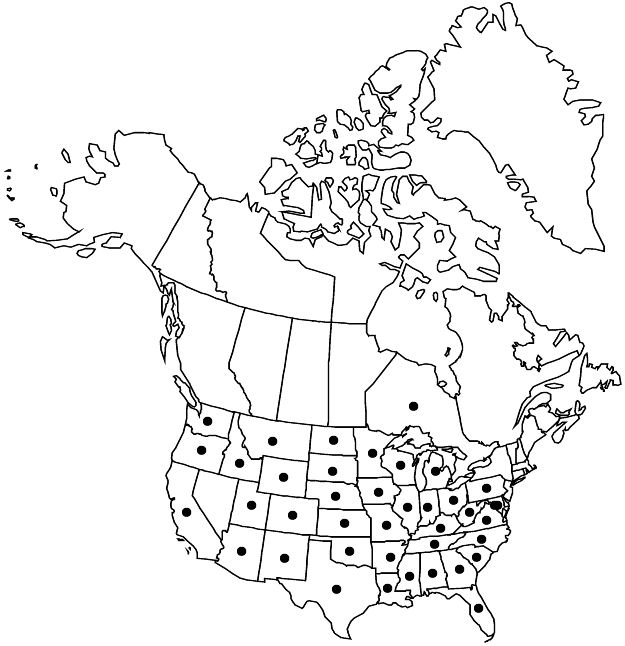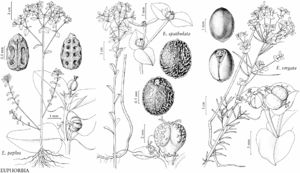Difference between revisions of "Euphorbia spathulata"
in J. Lamarck et al., Encycl. 2: 428. 1788.
FNA>Volume Importer |
imported>Volume Importer |
||
| (6 intermediate revisions by 2 users not shown) | |||
| Line 1: | Line 1: | ||
{{Treatment/ID | {{Treatment/ID | ||
|accepted_name=Euphorbia spathulata | |accepted_name=Euphorbia spathulata | ||
| − | |accepted_authority=Lamarck | + | |accepted_authority=Lamarck |
|publications={{Treatment/Publication | |publications={{Treatment/Publication | ||
| − | |title=Encycl. | + | |title=in J. Lamarck et al., Encycl. |
|place=2: 428. 1788 | |place=2: 428. 1788 | ||
|year=1788 | |year=1788 | ||
| Line 13: | Line 13: | ||
}}{{Treatment/ID/Special_status | }}{{Treatment/ID/Special_status | ||
|code=F | |code=F | ||
| − | |label= | + | |label=Illustrated |
}} | }} | ||
|basionyms= | |basionyms= | ||
| Line 19: | Line 19: | ||
|name=Euphorbia arkansana | |name=Euphorbia arkansana | ||
|authority=Engelmann & A. Gray | |authority=Engelmann & A. Gray | ||
| − | }}{{Treatment/ID/Synonym | + | |rank=species |
| + | }} {{Treatment/ID/Synonym | ||
|name=E. dictyosperma | |name=E. dictyosperma | ||
|authority=Fischer & C. A. Meyer | |authority=Fischer & C. A. Meyer | ||
| − | }}{{Treatment/ID/Synonym | + | |rank=species |
| + | }} {{Treatment/ID/Synonym | ||
|name=E. obtusata | |name=E. obtusata | ||
|authority=Pursh | |authority=Pursh | ||
| − | }}{{Treatment/ID/Synonym | + | |rank=species |
| + | }} {{Treatment/ID/Synonym | ||
|name=Galarhoeus arkansanus | |name=Galarhoeus arkansanus | ||
|authority=(Engelmann & A. Gray) Small ex Rydberg | |authority=(Engelmann & A. Gray) Small ex Rydberg | ||
| − | }}{{Treatment/ID/Synonym | + | |rank=species |
| + | }} {{Treatment/ID/Synonym | ||
|name=G. obtusatus | |name=G. obtusatus | ||
|authority=(Pursh) Small ex Rydberg | |authority=(Pursh) Small ex Rydberg | ||
| − | }}{{Treatment/ID/Synonym | + | |rank=species |
| + | }} {{Treatment/ID/Synonym | ||
|name=Tithymalus arkansanus | |name=Tithymalus arkansanus | ||
|authority=(Engelmann & A. Gray) Klotzsch & Garcke | |authority=(Engelmann & A. Gray) Klotzsch & Garcke | ||
| − | }}{{Treatment/ID/Synonym | + | |rank=species |
| + | }} {{Treatment/ID/Synonym | ||
|name=T. dictyospermus | |name=T. dictyospermus | ||
|authority=(Fischer & C. A. Meyer) A. Heller | |authority=(Fischer & C. A. Meyer) A. Heller | ||
| − | }}{{Treatment/ID/Synonym | + | |rank=species |
| + | }} {{Treatment/ID/Synonym | ||
|name=T. obtusatus | |name=T. obtusatus | ||
|authority=(Pursh) Klotzsch & Garcke | |authority=(Pursh) Klotzsch & Garcke | ||
| − | }}{{Treatment/ID/Synonym | + | |rank=species |
| + | }} {{Treatment/ID/Synonym | ||
|name=T. spathulatus | |name=T. spathulatus | ||
|authority=(Lamarck) W. A. Weber | |authority=(Lamarck) W. A. Weber | ||
| + | |rank=species | ||
}} | }} | ||
|hierarchy=Euphorbiaceae;Euphorbia;Euphorbia subg. Esula;Euphorbia spathulata | |hierarchy=Euphorbiaceae;Euphorbia;Euphorbia subg. Esula;Euphorbia spathulata | ||
| Line 58: | Line 67: | ||
|elevation=0–3500 m. | |elevation=0–3500 m. | ||
|distribution=Ont.;Ala.;Ariz.;Ark.;Calif.;Colo.;D.C.;Fla.;Ga.;Idaho;Ill.;Ind.;Iowa;Kans.;Ky.;La.;Md.;Mich.;Minn.;Miss.;Mo.;Mont.;Nebr.;N.Mex.;N.C.;N.Dak.;Ohio;Okla.;Oreg.;Pa.;S.C.;S.Dak.;Tenn.;Tex.;Utah;Va.;Wash.;W.Va.;Wis.;Wyo.;Mexico (Chihuahua;Sonora);s South America. | |distribution=Ont.;Ala.;Ariz.;Ark.;Calif.;Colo.;D.C.;Fla.;Ga.;Idaho;Ill.;Ind.;Iowa;Kans.;Ky.;La.;Md.;Mich.;Minn.;Miss.;Mo.;Mont.;Nebr.;N.Mex.;N.C.;N.Dak.;Ohio;Okla.;Oreg.;Pa.;S.C.;S.Dak.;Tenn.;Tex.;Utah;Va.;Wash.;W.Va.;Wis.;Wyo.;Mexico (Chihuahua;Sonora);s South America. | ||
| − | |discussion=<p>As treated here, Euphorbia spathulata is a wide-ranging and variable species. J. B. S. Norton (1900) recognized a number of segregates (for example, E. arkansana, E. dictyosperma, and E. obtusata) all of which are included here in a broadly defined E. spathulata. The only segregate species that has been widely recognized in regional floras is E. obtusata (for example, M. L. Fernald 1950; T. S. Cooperrider 1995; G. Yatskievych 1999–2013, vol. 2). Authors have generally distinguished the eastern North American E. obtusata from the western E. spathulata by the former's larger seeds (1.7–2.3 mm versus 1.5–1.7 mm) with smooth (versus reticulate) surfaces, larger involucres, red (versus yellow) involucral glands, and cordate-clasping (versus rounded to subcordate) dichasial bracts. Examination of specimens of E. spathulata in the broad sense from throughout North America showed that there is some geographic patterning to seed size and surface sculpturing, but the variation does not segregate cleanly into two discrete taxa. Plants from western North America typically have small seeds (1.5–1.7 mm) with reticulate surfaces, although some western individuals have seeds 1.8–1.9 mm long with reticulate surfaces. Plants from Texas generally have small seeds (1.5–1.6 mm) but with the surfaces either reticulate or completely smooth. Plants from adjacent Louisiana have small seeds with faintly reticulate to almost bumpy surfaces. Plants from eastern North America have larger seeds (2–2.3 mm) with usually smooth surfaces, although individuals from Tennessee and the Carolinas have faintly reticulate surfaces. Involucre height, gland color, and the shape of the dichasial bracts do not segregate with seed size as previous treatments have suggested.</p> | + | |discussion=<p>As treated here, <i>Euphorbia spathulata</i> is a wide-ranging and variable species. J. B. S. Norton (1900) recognized a number of segregates (for example, E. arkansana, E. dictyosperma, and E. obtusata) all of which are included here in a broadly defined <i>E. spathulata</i>. The only segregate species that has been widely recognized in regional floras is E. obtusata (for example, M. L. Fernald 1950; T. S. Cooperrider 1995; G. Yatskievych 1999–2013, vol. 2). Authors have generally distinguished the eastern North American E. obtusata from the western <i>E. spathulata</i> by the former's larger seeds (1.7–2.3 mm versus 1.5–1.7 mm) with smooth (versus reticulate) surfaces, larger involucres, red (versus yellow) involucral glands, and cordate-clasping (versus rounded to subcordate) dichasial bracts. Examination of specimens of <i>E. spathulata</i> in the broad sense from throughout North America showed that there is some geographic patterning to seed size and surface sculpturing, but the variation does not segregate cleanly into two discrete taxa. Plants from western North America typically have small seeds (1.5–1.7 mm) with reticulate surfaces, although some western individuals have seeds 1.8–1.9 mm long with reticulate surfaces. Plants from Texas generally have small seeds (1.5–1.6 mm) but with the surfaces either reticulate or completely smooth. Plants from adjacent Louisiana have small seeds with faintly reticulate to almost bumpy surfaces. Plants from eastern North America have larger seeds (2–2.3 mm) with usually smooth surfaces, although individuals from Tennessee and the Carolinas have faintly reticulate surfaces. Involucre height, gland color, and the shape of the dichasial bracts do not segregate with seed size as previous treatments have suggested.</p> |
|tables= | |tables= | ||
|references= | |references= | ||
| Line 67: | Line 76: | ||
-->{{#Taxon: | -->{{#Taxon: | ||
name=Euphorbia spathulata | name=Euphorbia spathulata | ||
| − | + | |authority=Lamarck | |
| − | |authority=Lamarck | ||
|rank=species | |rank=species | ||
|parent rank=subgenus | |parent rank=subgenus | ||
| Line 79: | Line 87: | ||
|distribution=Ont.;Ala.;Ariz.;Ark.;Calif.;Colo.;D.C.;Fla.;Ga.;Idaho;Ill.;Ind.;Iowa;Kans.;Ky.;La.;Md.;Mich.;Minn.;Miss.;Mo.;Mont.;Nebr.;N.Mex.;N.C.;N.Dak.;Ohio;Okla.;Oreg.;Pa.;S.C.;S.Dak.;Tenn.;Tex.;Utah;Va.;Wash.;W.Va.;Wis.;Wyo.;Mexico (Chihuahua;Sonora);s South America. | |distribution=Ont.;Ala.;Ariz.;Ark.;Calif.;Colo.;D.C.;Fla.;Ga.;Idaho;Ill.;Ind.;Iowa;Kans.;Ky.;La.;Md.;Mich.;Minn.;Miss.;Mo.;Mont.;Nebr.;N.Mex.;N.C.;N.Dak.;Ohio;Okla.;Oreg.;Pa.;S.C.;S.Dak.;Tenn.;Tex.;Utah;Va.;Wash.;W.Va.;Wis.;Wyo.;Mexico (Chihuahua;Sonora);s South America. | ||
|reference=None | |reference=None | ||
| − | |publication title=Encycl. | + | |publication title=in J. Lamarck et al., Encycl. |
|publication year=1788 | |publication year=1788 | ||
| − | |special status=Weedy; | + | |special status=Weedy;Illustrated |
| − | |source xml=https:// | + | |source xml=https://bitbucket.org/aafc-mbb/fna-data-curation/src/2e0870ddd59836b60bcf96646a41e87ea5a5943a/coarse_grained_fna_xml/V12/V12_345.xml |
|genus=Euphorbia | |genus=Euphorbia | ||
|subgenus=Euphorbia subg. Esula | |subgenus=Euphorbia subg. Esula | ||
Latest revision as of 19:14, 5 November 2020
Herbs, usually annual, rarely biennial, with taproot. Stems erect or ascending, unbranched or branched, 10–70 cm, glabrous. Leaves: petiole absent or to 0.2 mm; blade oblanceolate, oblong-oblanceolate, spatulate, or cuneate, 10–50 × 6–11 mm, base broadly attenuate to rounded or shallowly cordate-clasping, margins finely serrulate (usually distally), apex usually rounded to obtuse, occasionally slightly retuse or obcordate proximally, bluntly mucronate, surfaces glabrous; venation pinnate, midvein prominent. Cyathial arrangement: terminal pleiochasial branches 3(–5), each 1–3 times 2-branched; pleiochasial bracts broadly ovate to ovate-oblong, shorter and wider than distal leaves; dichasial bracts distinct, broadly ovate, ovate-triangular, or ovate-elliptic, base cordate-clasping or subcordate to rounded, margins serrulate, apex rounded to obtuse or acute; axillary cymose branches (0–4)5–12. Cyathia: peduncle 0.3–1(–1.5) mm. Involucre campanulate to cupulate, 0.6–1(–1.5) × 0.8–1.2 mm, glabrous; glands 4–5, elliptic, oblong, to slightly reniform, 0.2–0.6 × 0.4–1 mm; horns absent. Staminate flowers 3–10. Pistillate flowers: ovary glabrous; styles 0.8–1.5 mm, 2-fid. Capsules depressed-globose, 2–3.5 × 4 mm, 3-lobed; cocci rounded, verrucose, verrucae 0.1–0.2 mm, glabrous; columella 1.4–2.2 mm. Seeds red-brown to dark purple, occasionally ± glaucous, broadly ellipsoid-ovoid to nearly globose, 1.3–2.5 × 1.5–1.8 mm, smooth, reticulate, or finely low-ridged; caruncle irregularly reniform to round, subconic to lenticular, 0.3–0.4 × 0.5–0.6 mm.
Phenology: Flowering and fruiting spring–summer.
Habitat: Forests, fallow fields, prairies, pastures, glades, stream banks, waste places, roadsides.
Elevation: 0–3500 m.
Distribution

Ont., Ala., Ariz., Ark., Calif., Colo., D.C., Fla., Ga., Idaho, Ill., Ind., Iowa, Kans., Ky., La., Md., Mich., Minn., Miss., Mo., Mont., Nebr., N.Mex., N.C., N.Dak., Ohio, Okla., Oreg., Pa., S.C., S.Dak., Tenn., Tex., Utah, Va., Wash., W.Va., Wis., Wyo., Mexico (Chihuahua, Sonora), s South America.
Discussion
As treated here, Euphorbia spathulata is a wide-ranging and variable species. J. B. S. Norton (1900) recognized a number of segregates (for example, E. arkansana, E. dictyosperma, and E. obtusata) all of which are included here in a broadly defined E. spathulata. The only segregate species that has been widely recognized in regional floras is E. obtusata (for example, M. L. Fernald 1950; T. S. Cooperrider 1995; G. Yatskievych 1999–2013, vol. 2). Authors have generally distinguished the eastern North American E. obtusata from the western E. spathulata by the former's larger seeds (1.7–2.3 mm versus 1.5–1.7 mm) with smooth (versus reticulate) surfaces, larger involucres, red (versus yellow) involucral glands, and cordate-clasping (versus rounded to subcordate) dichasial bracts. Examination of specimens of E. spathulata in the broad sense from throughout North America showed that there is some geographic patterning to seed size and surface sculpturing, but the variation does not segregate cleanly into two discrete taxa. Plants from western North America typically have small seeds (1.5–1.7 mm) with reticulate surfaces, although some western individuals have seeds 1.8–1.9 mm long with reticulate surfaces. Plants from Texas generally have small seeds (1.5–1.6 mm) but with the surfaces either reticulate or completely smooth. Plants from adjacent Louisiana have small seeds with faintly reticulate to almost bumpy surfaces. Plants from eastern North America have larger seeds (2–2.3 mm) with usually smooth surfaces, although individuals from Tennessee and the Carolinas have faintly reticulate surfaces. Involucre height, gland color, and the shape of the dichasial bracts do not segregate with seed size as previous treatments have suggested.
Selected References
None.
